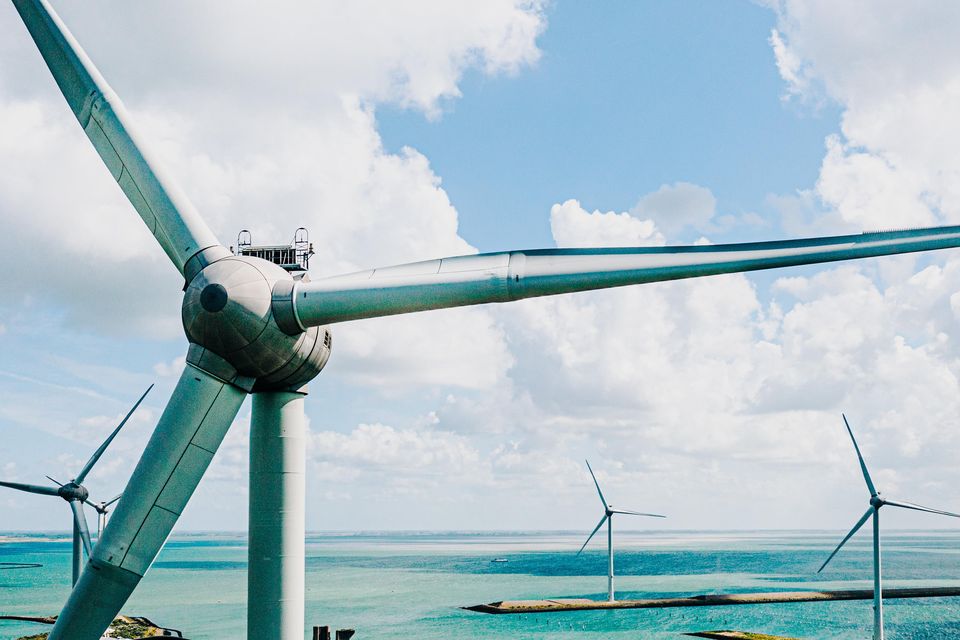‘True cost of meeting State’s renewable energy targets much higher than projections,’ ministers are warned
Households will face €750 per annum energy cost hike if the 2050 37GW goal is met
The Department of Public Expenditure said the cost to the public of creating the required infrastructure is likely to be 'significantly higher' than projections. Photo: Getty Images
Households are facing an extra €750 per year in energy costs by 2050 if the Government’s promises on renewable electricity are met, senior Cabinet ministers have been told by the Department of Public Expenditure.
The true cost of meeting ambitious renewable energy targets is likely to be “significantly higher”.
But the “net impact” of meeting these targets will mean hikes in electricity bills for households and business, top ministers have been warned.
Families would be facing an extra €750 a year on electricity costs in 2050 if the target of 37GW offshore renewable energy is met. By 2040, households will be already seeing an extra €100 per year in electricity bills.
The Government has committed to delivering 20GW of offshore wind by 2040 and at least 37GW in total by 2050.
However, a stark warning to ministers on the Cabinet sub-committee on climate in recent weeks lays out the risks and the true cost of the targets, the Irish Independent can reveal.
The projected costs to households and businesses are based on modelling which predicts the technology costs of offshore wind will halve in price and that other countries will help out with construction costs.
But the Department says the costs to the Irish public are likely to be “significantly higher in practice”, the Irish Independent understands.
The total projected costs of expanding offshore wind to 37GW is €131bn, which is similar to the State’s entire capital budget for nine years.
The Government hopes to tap into offshore wind energy in the hopes of then exporting it.
Putting in this infrastructure is very expensive, while maintaining it will also be very costly. It would cost around €1.2bn to support 1GW on the grid, and for 37GW of new capacity, the cost is estimated to be €44bn – just for supporting grid infrastructure.
In 2022, Green Party leader Eamon Ryan unveiled the €1.6bn Celtic Interconnector in Paris. The cable is able to move 700MW of electricity from Ireland to France.
If Ireland was to meet targets of 37GW of offshore wind, then interconnectors of up to a capacity of a further 14GW would be needed to export to other countries.
Putting in the necessary cables alone to export the energy would cost €32bn, separate analysis from the Department of Climate suggests.
While the Government hopes to export a lot of the offshore renewable energy, it is vital that there are huge benefits for other countries, and this may not necessarily be the case, ministers were told.
For example, France is moving towards nuclear energy which is cheaper than the renewable energy Ireland has on offer.
Another challenge of meeting the 37GW target by 2050 is the need to have a booming green hydrogen market in Ireland.
However, it is expected that hydrogen in other European countries is likely to be cheaper than that in Ireland.
The Department of Public Expenditure told ministers Ireland needs to “drastically” drive down the cost of electricity, including renewable electricity, to create a viable export market.
As Ireland hopes to export its massive wind energy investment to other European countries, they will have to pitch into the €131bn cost of putting in the infrastructure, ministers were advised.
But the scale of the infrastructure which will be needed to do this “does not exist today”.
It is also unlikely that taxpayers in other countries would be willing to bear the costs of paying for another state’s renewable energy infrastructure.
Read more
Other EU member states may not be “willing” to make too many compromises.
A spokesperson for the Department of Public Expenditure said: “Due to the fact that Cabinet confidentiality extends to the content and details of discussions at meetings of the Government, we will not be commenting.”
A spokesperson for the Department of the Environment also said it would not comment. However, a source in the Department said 37GW offshore wind “could be worth at least €38bn to the Irish economy”, according to a report by Green Tech Skills Net and Wind Energy Ireland.
They said Ireland has plans to engage at EU level “to support future market design developments”.
The State has “enormous potential to become a net energy exporter, and to become central to wider European energy plans”, the source said.
The Department of Enterprise, Trade and Employment is currently working with Enterprise Ireland and the IDA to develop Ireland’s first offshore wind industrial strategy.
It is due to be published at some stage this year and will focus on Ireland’s R&D efforts in offshore wind, while also growing and supporting the Irish supply chain for the sector, locally and in the global market.
Join the Irish Independent WhatsApp channel
Stay up to date with all the latest news











